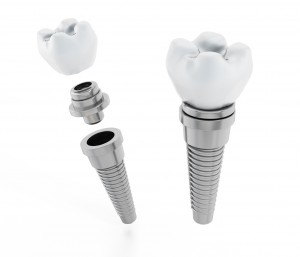 Dental implants are becoming a more common procedure these days as a way to replace missing teeth or irreversibly damaged teeth. In fact, you probably know someone who has gotten implants, or maybe you’re considering them instead of a bridge or denture. But, what exactly is a dental implant, and what’s it like to get one? We’ve got the answers to all of your questions right here!
Dental implants are becoming a more common procedure these days as a way to replace missing teeth or irreversibly damaged teeth. In fact, you probably know someone who has gotten implants, or maybe you’re considering them instead of a bridge or denture. But, what exactly is a dental implant, and what’s it like to get one? We’ve got the answers to all of your questions right here!
What’s an implant and why might I need one?
When you’re missing a tooth or if the roots of a tooth are irreversibly damaged from decay or injury, your only option used to be getting dentures, or a bridge. The former is somewhat like a retainer with a replacement tooth on it that can be inserted and removed from the mouth as needed, and the latter consists of a prosthetic tooth anchored to the surrounding teeth. In contrast, a dental implant is a standalone prosthetic tooth that consists of three parts: a screw-like fixture that acts as the roots, the abutment to secure the crown, and the crown itself that mimics the look and function of a real tooth. Implants are usually made from titanium because they fuse to bone well and help prevent any further bone loss, if there is any.
If a patient has lost multiple teeth in a row, a dentist can actually create a bridge using implants, and implants can also be used to anchor upper and lower dentures in place. Implants are also removable, in the event that it becomes damaged or otherwise needs to be replaced.
What is the procedure like?
It will take several visits in order to properly plan and place your implant, and the process often takes place over several months to account for the healing time. First and foremost, your dentist will need to take x-rays of your jaw to see if there has been any bone loss or degradation along the jawline where the implant will be placed. If there is, you may need to undergo surgery to add bone to the area in order to support and anchor the implant. This surrounding bone in the jaw is what helps hold the implant in place, so it’s very important to ensure there is a good foundation or the implant might fail.
Next, the dentist will perform a surgical procedure to install the implant fixture. This consists of making an incision into the gum and drilling into the jaw. Then, the implant fixture is installed into this area — the bone will heal and grow around it, which is what helps make implants such a strong and permanent fix. Then, the gum will be stitched up over the implant in order to protect it while the gums and jaw heal, which is often a period of three to six months.
The next stage is placing the abutment or the part of the implant that protrudes above the gum line and anchors the cap. The dentist will need to cut away excess gum that has healed over the implant to install the abutment, and you will again need to allow your gums to heal for a few weeks or months before proceeding to the last step.
Finally, a crown will be installed over the abutment to mimic the look and feel of the missing tooth. In between procedures, you may have to go back for checkups to ensure that the implant is healing properly and adhering to the surrounding bone. There are also now different kinds of implant surgeries that are done in only one or two settings, but the three-stage procedure is still the most common.
Give it to me straight — will it hurt, and what’s the success rate?
Although every patient is different, there should be minimal discomfort during the implant procedure itself and during the healing process. A local anesthesia is used during the surgery to minimize any pain, and while the healing process does take several months, this is because it takes time for the implant to properly adhere and anchor to the bone. So, don’t think you’ll be in pain for six months!
You should only have mild discomfort and swelling immediately after each procedure, which can be managed with over-the-counter pain relievers. After the first procedure when the implant fixture is installed, you will need to eat and drink only soft foods and be careful not to disturb the blood clot. However, you’ll be back to normal within 2-3 days. After the abutment procedure, you may experience some swelling, and it’s possible that the abutment may come out. You should contact your dentist immediately to have it replaced, but this won’t damage the implant. You should have minimal to no pain after installing the cap.
The success rate for implants is quite high, at about 95-98%. Failure of an implant is often due to poor overall health of your mouth and jawbone, underlying health issues such as diabetes or heart disease, as well as poor oral hygiene following the procedures. However, these issues are rare, and implants are considered one of the most successful surgical dental procedures one can undergo.
If you have any additional questions or concerns about dental implants, talk with your dentist or drop us a line. Have you gone through implant surgery? Let us know about your experience in the comments!







Leave a Reply